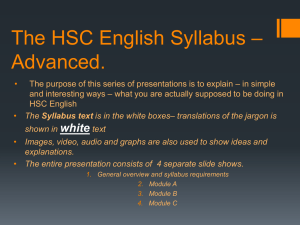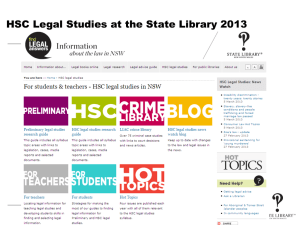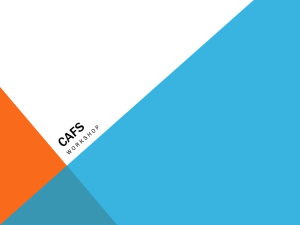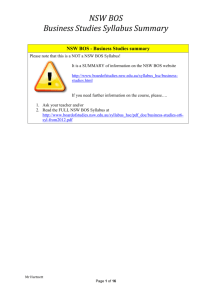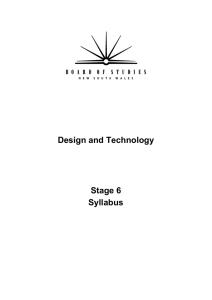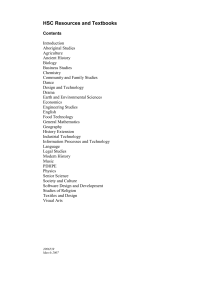SAC_Website_Introduction - Society and Culture Association
advertisement
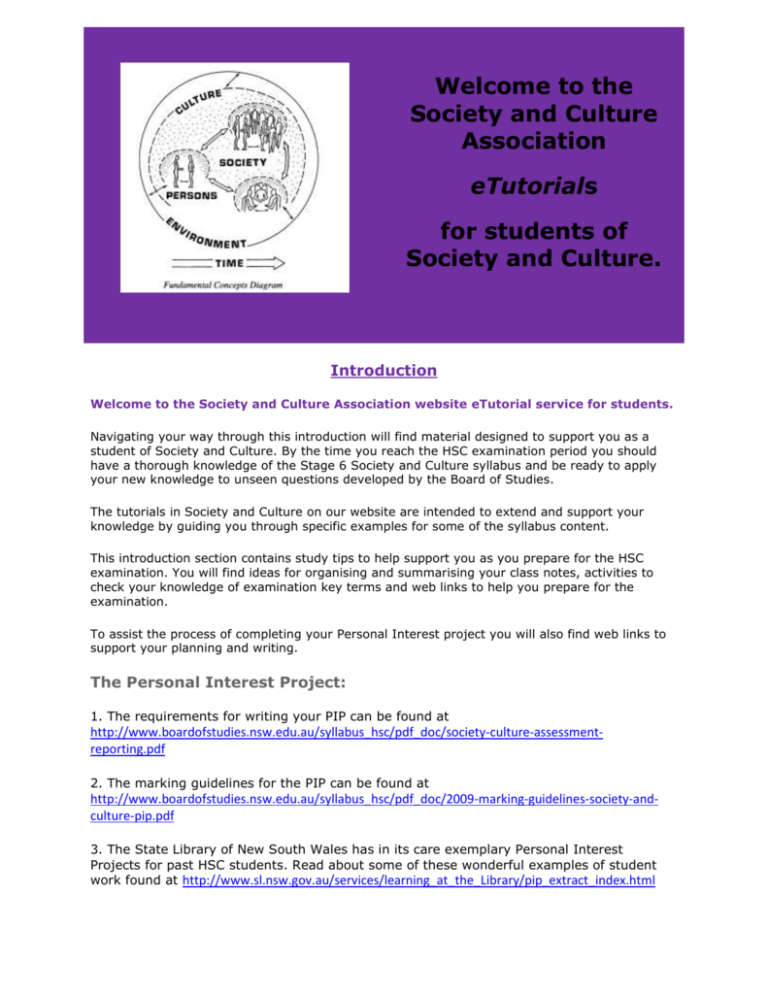
Welcome to the Society and Culture Association eTutorials for students of Society and Culture. Introduction Welcome to the Society and Culture Association website eTutorial service for students. Navigating your way through this introduction will find material designed to support you as a student of Society and Culture. By the time you reach the HSC examination period you should have a thorough knowledge of the Stage 6 Society and Culture syllabus and be ready to apply your new knowledge to unseen questions developed by the Board of Studies. The tutorials in Society and Culture on our website are intended to extend and support your knowledge by guiding you through specific examples for some of the syllabus content. This introduction section contains study tips to help support you as you prepare for the HSC examination. You will find ideas for organising and summarising your class notes, activities to check your knowledge of examination key terms and web links to help you prepare for the examination. To assist the process of completing your Personal Interest project you will also find web links to support your planning and writing. The Personal Interest Project: 1. The requirements for writing your PIP can be found at http://www.boardofstudies.nsw.edu.au/syllabus_hsc/pdf_doc/society-culture-assessmentreporting.pdf 2. The marking guidelines for the PIP can be found at http://www.boardofstudies.nsw.edu.au/syllabus_hsc/pdf_doc/2009-marking-guidelines-society-andculture-pip.pdf 3. The State Library of New South Wales has in its care exemplary Personal Interest Projects for past HSC students. Read about some of these wonderful examples of student work found at http://www.sl.nsw.gov.au/services/learning_at_the_Library/pip_extract_index.html 4 The Society and Culture web site also has interesting information about PIPs. Click here to read article written specifically about preparing the PIP http://scansw.com.au/sc_pages/sc_pip.html To read extracts from past award winning PIPs click here http://scansw.com.au/sc_pages/sc_awards.html 5. Examples of Personal Interest Projects from students judged at band achievement levels can be found at http://arc2.bos.nsw.edu.au/view/byarea/course/15350/question/2582 SIX Study Suggestions to prepare for the exam: 1. Have a thorough understanding of the syllabus which is available from the NSW Board of Studies o To gain a thorough knowledge of the Society and Culture content and to be exam ready, an understanding of the syllabus is needed. o You need to be very familiar with each bullet point of the syllabus. If you don't have a copy of the syllabus, download one. o Click here to find the syllabus http://www.boardofstudies.nsw.edu.au/syllabus_hsc/society-culture.html) 2. Have a good understanding of the layout of the exam paper for Society and Culture: Understanding the layout of the examination for Society and Culture helps to prepare you for the exam. You will need to follow the recommended times for completing each of the three sections of paper e.g. o o o o Section 1 allow about 40 minutes Section 2 allow about 40 minutes Section 3 allow about 40 minutes For section 3 construct an answer of around about 800 words Past examination papers (LINK to ( http://www.boardofstudies.nsw.edu.au/hsc_exams/hsc2012exams/ ) are available from the NSW Board of Studies. 3. Organise and summarise your class notes: To help organise, summarise and revise your class notes select the following links to download a table for the core and depth studies. o Core Summary table o Popular Culture o Belief systems o Equality and Difference o Work and Leisure or……. o Each table contains syllabus bullet points for that area of study. o Summarise your class notes for each bullet point in the table. o Remember examination questions are generated to assess your level of understanding of these bullet points. 4. Practice answering multiple choice questions: Be very familiar with answering multiple choice questions as this will help you prepare for the examination. o o o o o o All answers for multiple choice questions are usually plausible however; there is only ONE correct answer. In each question you must select the most appropriate response from a list of alternatives. Incorrect answers are usually based on common student misconceptions or misunderstandings. For information of answering multiple choice questions select Academictips.org To practice answering multiple choice questions for Society and Culture, go to the past papers and ………Board of Studies website. Access to the ARC web site also helps with understanding multiple choice questions http://arc2.bos.nsw.edu.au/statistical/default/course/15350/band/5 or http://arc2.bos.nsw.edu.au/view/default/course/15350 4. Familiarise yourself with the Board of Studies glossary of key terms o o For success in the Society and Culture examination you will be required to apply your knowledge to answer any combination of syllabus bullet points selected. Each question asked may have an instructional verb chosen from the Board of Studies glossary of key terms. To check your understanding for some of the key terms complete the Click and Drag activity. 5. Practice answering exam type questions – short, structured and extended: o Once you have revised sections of your work then choose a syllabus bullet point and practice how you would apply this knowledge using your understanding of a key word from the Board of Studies glossary. o After completing this type of activity you will notice how you are beginning to apply your knowledge of the syllabus content. o In the extended response section of the paper you will be assesses on how well you have achieved the rubric. To check your understanding of the rubric click here http://www.boardofstudies.nsw.edu.au/syllabus_hsc/society-culture-examrubrics.html o o Practise planning your response and writing around 800 words or about six examination booklet pages for responses in section III. An important part of your revision routine should be looking at the marking guidelines for any past question and heeding the advice of the marking centre. Go to the Board of Studies marking guidelines. for past Society and Culture HSC papers and their 6. Look closely at samples of student work judged at the performance band standards. Students responses to past examination questions and tasks are found on the Assessment and Resource Centre website. Go to the ARC web site and explore examples of student work judged against the standards of performance bands. http://arc2.bos.nsw.edu.au/view/default/course/15350 To read more about standards referenced assessment go to “frequently asked questions” http://arc2.bos.nsw.edu.au/page/faq/course/15350 Student performance in the Higher School Certificate examinations is reported according to standards (or levels of achievement). HSC marks for non-extension courses are divided into 6 performance bands to understand more about the standards go to http://arc2.bos.nsw.edu.au/page/about-the-standards/course/15350 Now you are well on your way to being exam ready! Suggested tutorial scaffold Syllabus area Title Targeted Outcome Introduction Bullet point/s Activity Web link Exam type questions Suggested answers ? An example of a tutorial: HSC Belief systems Depth Study: BELIEF SYSTEMS Concept revision: In this tutorial you will check your understanding of the some of the depth study concepts and then apply them to examples in order to understand the relationship concepts have with your focus study in the depth study. Check your thinking for the definition of the concept below: Click here http://www.youtube.com/watch?v=V35UUVs5t60. and view the short film.\ 1. Identify an example of each concept in the film. 2. Record your example in the scaffold below and then revise the definition of the concept. 3. Outline the relationship ‘symbols and rituals’ have in your focus study. Concept Customs Beliefs Continuity Norms Symbols Rituals Globalisation Myths Philosophy Definition Example from the film Relationship between the concept and your focus study Another example: Of what an eTutorial may look like Preliminary Course: The social and cultural world Title: Understanding the interactions between the fundamental course concepts In this tutorial you will check your understanding of the fundamental course concepts and then apply them to examples in order to understand the relationship concepts have with each other. Syllabus bullet point: apply the fundamental concepts to TWO of the following: School, family, media and a group of which the student is a member. The fundamental course concepts and the interaction between them are important in understanding the society in which we live. To check your understanding of the definition of these important concepts click on the following link and scroll to page 15 http://www.boardofstudies.nsw.edu.au/syllabus_hsc/pdf_doc/societyculture-st6-syl-from2010.pdf Now that you have checked your understanding of the five fundamental course concepts choose any two examples from the following and complete the activity. o school o family http://www.abs.gov.au/ausstats/ abs@.nsf/Lookup/4125.0main+fe atures2110Jan%202013 http://www.sbs.com.au/shows/thefa mily/watchonlineplaylist/page/i/1/h/ Watch-Online/vid/539403 Click on the link, read the information on education retention rates and outline the relationship between - person and culture OR - Personal and society Click on the link and view the short film the outline the relationship between - culture and time OR - society and culture o the media http://www.news.com.au/tech nology/facebook-is-taking-overaustralian-teenagerspsychologists-say/storye6frfro0-1226208648857 Click on the following link, read the article and outline the relationship either – time and culture OR – Person and culture o a group belong to you Example: sport, leisure Choose a group you belong to and outline an interaction between culture and society.

